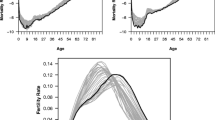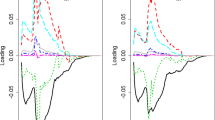Abstract
Probabilistic household forecasts to 2041 are presented for Denmark, Finland, and the Netherlands. Future trends in fertility, mortality and international migration are taken from official population forecasts. Time series of shares of the population in six different household positions are modelled as random walks with drift. Brass’ relational model preserves the age patterns of the household shares. Probabilistic forecasts for households are computed by combining predictive distributions for the household shares with predictive distributions of the populations, specific for age and sex. If current trends in the three countries continue, we will witness a development towards more and smaller households, often driven by increasing numbers of persons who live alone. We can be quite certain that by 2041, there will be between two and four times as many persons aged 80 and over who live alone when compared with the situation in 2011.



Data sources: 1981–2001 register data; 2011 census data, Eurostat 2014, 2021–2041 model extrapolations. (For interpretation of the references to colour in this figure legend, the reader is referred to the web version of this article.)

Data sources: 1991–2001 register data; 2011 census data, Eurostat 2014; 2021–2041 model extrapolations. (For interpretation of the references to colour in this figure legend, the reader is referred to the web version of this article.)

Data sources: 2001 register data; 2011 census data, Eurostat 2014, 2021–2041 model extrapolations. (For interpretation of the references to colour in this figure legend, the reader is referred to the web version of this article.)

Source: Eurostat (2014). (For interpretation of the references to colour in this figure legend, the reader is referred to the web version of this article.)

Similar content being viewed by others
References
Alders, M. (1999). Stochastische huishoudensprognose 1998–2050 [Stochastic household forecast 1998–2050]. Maandstatistiek van de Bevolking, 47(11), 25–34.
Alders, M. (2001). Huishoudensprognose 2000–2050: Veronderstellingen over onzekerheidsmarges [Household forecast 2000–2050: Assumptions on uncertainty intervals]. Maandstatistiek van de Bevolking, 49(8), 14–17.
Alders, M., Keilman, N., & Cruijsen, H. (2007). Assumptions for long-term stochastic population forecasts in 18 European countries. European Journal of Population, 23(1), 33–69. doi:10.1007/s10680-006-9104-4.
Alho, J., Alders, M., Cruijsen, H., Keilman, N., Nikander, T., & Quang Pham, D. (2006). New forecast: Population decline postponed in Europe. Statistical Journal of the United Nations ECE, 12(23), 1–10.
Alho, J., Cruijsen, H., & Keilman, N. (2008). Empirically based specification of forecast uncertainty. In J. Alho, S. Jensen, & J. Lassila (Eds.), Uncertain demographics and fiscal sustainability (pp. 34–54). Cambridge: Cambridge University Press. doi:10.1017/CBO9780511493393.004.
Alho, J., & Keilman, N. (2010). On future household structure. Journal of the Royal Statistical Society Series A, 173(1), 117–143. doi:10.1111/j.1467-985X.2009.00605.x.
Bijak, J., Alberts, I., Alho, J., Bryant, J., Buettner, T., Falkingham, J., et al. (2015). Uncertain population forecasting: A case for practical uses. Journal of Official Statistics, 30(4), 537–544.
Brass, W. (1971). On the scale of mortality. In W. Brass (Ed.), Biological aspects of demography (pp. 69–110). London: Taylor & Francis.
Christiansen, S. G. (2015). Empirical studies of Nordic household and family structure. Ph.D. dissertation, Faculty of Social Sciences, University of Oslo. https://www.duo.uio.no/handle/10852/47624.
Christiansen, S. G., & Keilman, N. (2013). Probabilistic household forecasts based on register data—The case of Denmark and Finland. Demographic Research. doi:10.4054/DemRes.2013.28.43.
Cooper, J., Ueffing, Ph., & Wilson, T. (2015). An overview of household change in Queensland, 2006–11. Queensland Centre for Population Research, School of Geography, Planning and Environmental Management, The University of Queensland.
Daatland, S. O. (Ed.) (1997). De siste årene: Eldreomsorgen i Skandinavia 1960–95 (The final years: Elderly care in Scandinavia 1960–95). NOVA Report 22/1997. Oslo: Norwegian Social Research. http://www.hioa.no/Om-HiOA/Senter-for-velferds-og-arbeidslivsforskning/NOVA/Publikasjonar/Rapporter/1997/De-siste-aarene.
De Beer, J., & Alders, M. (1999). Probabilistic population and household forecasts for the Netherlands. Joint Economic Commission for Europe–EUROSTAT Work Session on Demographic Projections, Perugia, 3–7 May (Working paper 45).
Eurostat. (2014). http://ec.europa.eu/eurostat/web/population-and-housing-census/census-data/2011-census.
Greene, W. H. (2003). Econometric analysis (5th ed.). New Jersey: Prentice Hall.
Grundy, E., & Jital, M. (2007). Socio-demographic variations in moves to institutional care 1991–2001: A record linkage study from England and Wales. Age and Ageing, 36(4), 424–430.
Haupt, H., Oberhofer, W., & Reichsthaler, T. (2003). A varying-coefficient approach to estimation and extrapolation of household size. Mathematical Population Studies, 10, 249–273.
.id (2012). http://blog.id.com.au/2012/housing-analysis/australian-housing-trends/2011-census-our-expanding-households/. Accessed 3 June 2016.
Jacobsen, R. H., & Jensen, S. E. H. (2014). Future changes in age and household patterns: Some implications for public finances. International Journal of Forecasting, 30(4), 1110–1119.
Jiang, L., & O’Neill, B. (2004). Toward a new model for probabilistic household forecasts. International Statistical Review, 72(1), 51–64.
Keilman, N. (2016). Household forecasting: Preservation of age patterns. International Journal of Forecasting, 32(3), 726–735.
Lakdawalla, D., Goldman, D. P., Bhattacharya, J., Hurd, M., Joyce, G., & Panis, C. (2003). Forecasting the nursing home population. Medical Care, 41(1), 8–20.
Lakdawalla, D., & Philipson, T. (1999). Ageing and the growth of long-term care. NBER Working Paper Series, National Bureau of Economic Research, http://www.nber.org/papers/w6980.
Lee, R., & Miller, T. (2001). Evaluating the performance of the lee-carter method for forecasting mortality. Demography, 38(4), 537–549.
Linke, W. (1988). The headship rate approach in modelling households: The case of the Federal Republic of Germany. In N. Keilman, A. Kuijsten, & A. Vossen (Eds.), Modelling household formation and dissolution (pp. 108–122). Oxford: Clarendon Press.
Matsudaira, J. (2016). Economic conditions and the living arrangements of young adults: 1960 to 2011. Journal of Population Economics, 29(1), 167–195.
Muller, C., Gnanasekaran, K., & Knapp, K. (1999). Housing and living arrangements for the elderly: an International Comparison Study. New York: International Longevity Center.
O’Neill, B., & Chen, B. (2002). Demographic determinants of household energy use in the United States. Population and Development Review, 28(Suppl.), 53–88.
OECD. (2011). Doing better for families. Paris: OECD Publishing.
Peters, A., & Liefbroer, A. C. (1997). Beyond marital status: Partner history and well-being in old age. Journal of Marriage and the Family, 59(3), 687–699.
Preston, S., Heuveline, P., & Guillot, M. (2001). Demography: Measuring and modelling population processes. Oxford: Blackwell.
Scherbov, S., & Ediev, D. (2007). Probabilistic household projections based on an extension of headship rates method with application to the case of Russia. Joint Economic Commission for Europe–EUROSTAT Work Session on Demographic Projections, Bucharest, 10–12 October (Working paper 16).
Spersrud, I. (2012). Finske eldre i fremtiden: En studie av institusjonskapasitetens effect på husholdningsstruktur [Finnish elderly in the future: An analysis of the effect of institutional capacity on the structure of households]. M.Sc. dissertation Department of Economics, University of Oslo. https://www.duo.uio.no/handle/10852/17115.
Statistics Netherlands. (2016). http://statline.cbs.nl/Statweb/publication/?DM=SLNL&PA=83232ned&D1=a&D2=0&D3=a&D4=0,5,15,25&HDR=T&STB=G1,G2,G3&VW=T. Accessed 3 June 2016.
Stoeldraijer, L. (2014). Jongeren blijven langer thuis wonen [Adolescents stay longer in the parental home]. Bevolkingstrends June 2014: 2–14. http://www.cbs.nl/NR/rdonlyres/6EB95395-FEE2-4744-931A-07A85B2E3042/0/20140406b15art.pdf.
United Nations. (1973). Methods of projecting households and families. New York: United Nations.
United Nations. (2010). World Population Ageing 2009. ST/ESA/SER.A/295. New York: United Nations.
United Nations Economic Commission for Europe. (2006). Recommendations for the 2010 Censuses of Population and Housing, jointly prepared by the United Nations Economic Commission for Europe and the Statistical Office of the European Communities. Geneva: United Nations.
United States Census Bureau. (2014). 65+ in the United States: 2010. Washington, DC: U.S. Government Printing Office.
US National Resources Planning Committee. (1938). The problems of a changing population. Washington DC: Government Printing Office.
United States Census Bureau. (2016). http://www.census.gov/hhes/families/files/graphics/HH-6.pdf. Accessed 3 June 2016.
Van Duin, C., & Stoeldraijer, L. (2014). Bevolkingsprognose 2014–2060: Groei door migratie [Population forecast 2014–2060: Growth due to migration]. Bevolkingstrends, 1–22.
Van Duin, C., Stoeldraijer, L., & Garssen, J. (2013). Huishoudensprognose 2013–2060: Sterke toename oudere alleenstaanden [Household forecast 2013–2060: Strong increase for elderly living alone]. Bevolkingstrends, 2–26.
Van Vliet, W., Huttman, E., & Fava, S. (Eds.). (1985). Housing needs and policy approaches: Trends in thirteen countries. Durham: Duke University Press.
Wilson, T. (2013a). Quantifying the uncertainty of regional demographic forecasts. Applied Geography, 42(August), 108–115.
Wilson, T. (2013b). The sequential propensity household projection model, Demographic Research, 28(24), 681–712. http://www.demographic-research.org/volumes/vol28/24/28-24.pdf.
Acknowledgments
This work was supported by the European Commission’s Seventh Framework Programme under Grant FP7-SSH-2012-1/No. 320333. We acknowledge useful comments by Coen van Duin, Juha Alho, and members of the WP2 Research Team of the MOPACT (“Mobilising the Potential of Active Ageing in Europe”) project.
Author information
Authors and Affiliations
Corresponding author
Appendix: Back transformation from ξ to α
Appendix: Back transformation from ξ to α
In “Modelling household shares” section the shares α j are transformed into fractions ξ k . In this “Appendix” we outline the back transformation from ξ k to α j . We suppress indices for age, sex, time, and country. The starting point is the set of expressions that transform the shares α j into fractions ξ k .
There are many equivalent expressions for the α j written as functions of the ξ k . One of these is the following set
By assumption, α 1 is independent of ξ k (k = 2, 3,…6).
Rights and permissions
About this article
Cite this article
Keilman, N. A combined Brass-random walk approach to probabilistic household forecasting: Denmark, Finland, and the Netherlands, 2011–2041. J Pop Research 34, 17–43 (2017). https://doi.org/10.1007/s12546-016-9175-y
Published:
Issue Date:
DOI: https://doi.org/10.1007/s12546-016-9175-y




